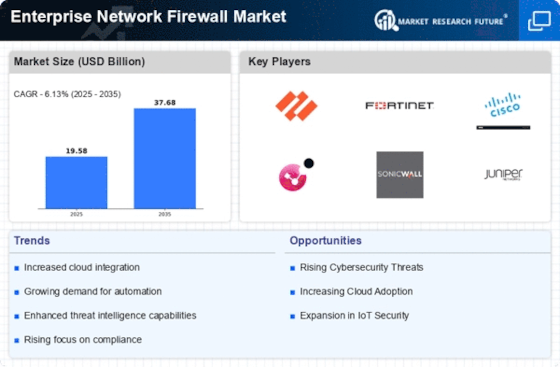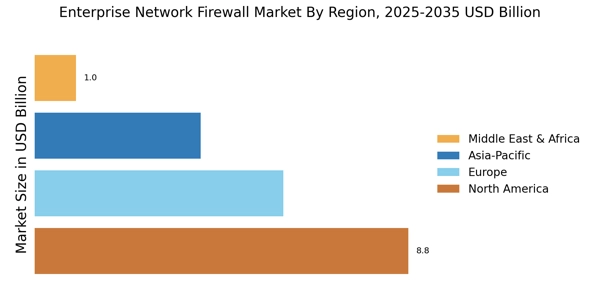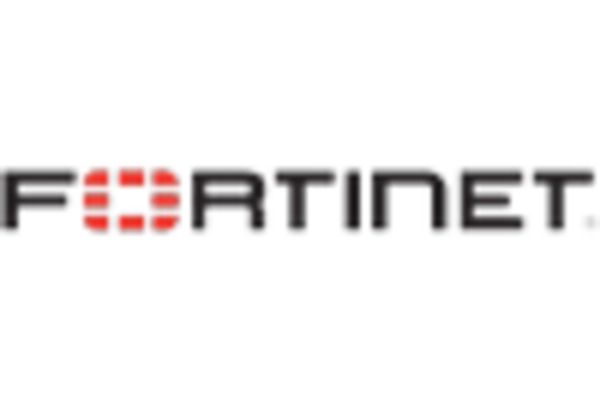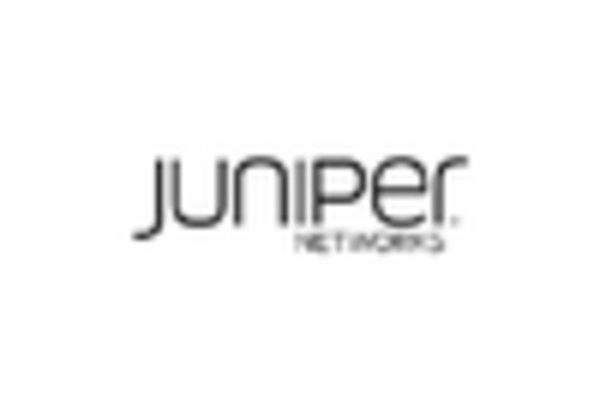The Enterprise Network Firewall Market is currently characterized by a dynamic competitive landscape, driven by the increasing demand for robust cybersecurity solutions amid rising cyber threats. Key players such as Palo Alto Networks (US), Fortinet (US), and Cisco Systems (US) are at the forefront, each adopting distinct strategies to enhance their market positioning. Palo Alto Networks (US) emphasizes innovation through continuous product development, focusing on advanced threat detection and response capabilities. Fortinet (US), on the other hand, leverages its integrated security fabric to provide comprehensive solutions, while Cisco Systems (US) is enhancing its offerings through strategic partnerships and acquisitions, thereby broadening its service portfolio and geographical reach. Collectively, these strategies contribute to a competitive environment that is increasingly focused on technological advancement and customer-centric solutions.
In terms of business tactics, companies are increasingly localizing manufacturing and optimizing supply chains to enhance operational efficiency and responsiveness to market demands. The competitive structure of the Enterprise Network Firewall Market appears moderately fragmented, with several key players exerting influence. This fragmentation allows for a diverse range of solutions, catering to various customer needs, while also fostering innovation as companies strive to differentiate themselves in a crowded marketplace.
In August 2025, Palo Alto Networks (US) announced the launch of its next-generation firewall, which integrates artificial intelligence to enhance threat detection capabilities. This strategic move is significant as it positions the company to address the evolving landscape of cyber threats, where traditional methods may fall short. By incorporating AI, Palo Alto Networks (US) not only improves its product offering but also reinforces its commitment to innovation, potentially attracting a broader customer base seeking advanced security solutions.
In September 2025, Fortinet (US) expanded its global presence by entering into a strategic partnership with a leading telecommunications provider in Asia. This collaboration aims to deliver integrated security solutions to a wider audience, particularly in emerging markets. The strategic importance of this partnership lies in Fortinet's ability to leverage the telecommunications provider's extensive network infrastructure, thereby enhancing its market penetration and customer reach in a region that is increasingly prioritizing cybersecurity.
In October 2025, Cisco Systems (US) unveiled a new initiative focused on sustainability within its product lines, aiming to reduce the environmental impact of its firewall solutions. This initiative reflects a growing trend among enterprises to prioritize sustainability alongside security. By aligning its operational strategies with environmental considerations, Cisco Systems (US) not only enhances its brand reputation but also positions itself favorably among environmentally conscious consumers and businesses.
As of October 2025, the competitive trends within the Enterprise Network Firewall Market are increasingly defined by digitalization, sustainability, and the integration of artificial intelligence. Strategic alliances are playing a crucial role in shaping the current landscape, enabling companies to pool resources and expertise to deliver more comprehensive solutions. Looking ahead, it appears that competitive differentiation will evolve from traditional price-based competition to a focus on innovation, technological advancement, and supply chain reliability, as companies seek to meet the complex demands of a rapidly changing cybersecurity environment.


















Leave a Comment